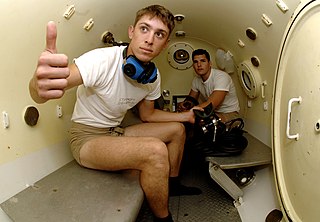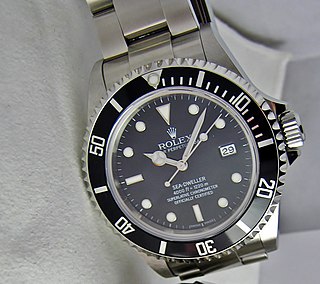Related Research Articles
Nitrox refers to any gas mixture composed of nitrogen and oxygen. This includes atmospheric air, which is approximately 78% nitrogen, 21% oxygen, and 1% other gases, primarily argon. In the usual application, underwater diving, nitrox is normally distinguished from air and handled differently. The most common use of nitrox mixtures containing oxygen in higher proportions than atmospheric air is in scuba diving, where the reduced partial pressure of nitrogen is advantageous in reducing nitrogen uptake in the body's tissues, thereby extending the practicable underwater dive time by reducing the decompression requirement, or reducing the risk of decompression sickness.

Narcosis while diving is a reversible alteration in consciousness that occurs while diving at depth. It is caused by the anesthetic effect of certain gases at high pressure. The Greek word νάρκωσις (narkōsis), "the act of making numb", is derived from νάρκη (narkē), "numbness, torpor", a term used by Homer and Hippocrates. Narcosis produces a state similar to drunkenness, or nitrous oxide inhalation. It can occur during shallow dives, but does not usually become noticeable at depths less than 30 meters (100 ft).

Trimix is a breathing gas consisting of oxygen, helium and nitrogen and is used in deep commercial diving, during the deep phase of dives carried out using technical diving techniques, and in advanced recreational diving.
Heliox is a breathing gas mixture of helium (He) and oxygen (O2). It is used as a medical treatment for patients with difficulty breathing because mixture generates less resistance than atmospheric air when passing through the airways of the lungs, and thus requires less effort by a patient to breathe in and out of the lungs. It is also used as a breathing gas diluent for deep ambient pressure diving as it is not narcotic at high pressure, and for its low work of breathing.

Deep diving is underwater diving to a depth beyond the norm accepted by the associated community. In some cases this is a prescribed limit established by an authority, while in others it is associated with a level of certification or training, and it may vary depending on whether the diving is recreational, technical or commercial. Nitrogen narcosis becomes a hazard below 30 metres (98 ft) and hypoxic breathing gas is required below 60 metres (200 ft) to lessen the risk of oxygen toxicity.

A breathing gas is a mixture of gaseous chemical elements and compounds used for respiration. Air is the most common and only natural breathing gas, but other mixtures of gases, or pure oxygen, are also used in breathing equipment and enclosed habitats such as scuba equipment, surface supplied diving equipment, recompression chambers, high-altitude mountaineering, high-flying aircraft, submarines, space suits, spacecraft, medical life support and first aid equipment, and anaesthetic machines.

Saturation diving is diving for periods long enough to bring all tissues into equilibrium with the partial pressures of the inert components of the breathing gas used. It is a diving mode that reduces the number of decompressions divers working at great depths must undergo by only decompressing divers once at the end of the diving operation, which may last days to weeks, having them remain under pressure for the whole period. A diver breathing pressurized gas accumulates dissolved inert gas used in the breathing mixture to dilute the nitrogen to a non-toxic level in the tissues, which can cause decompression sickness if permitted to come out of solution within the body tissues; hence, returning to the surface safely requires lengthy decompression so that the inert gases can be eliminated via the lungs. Once the dissolved gases in a diver's tissues reach the saturation point, however, decompression time does not increase with further exposure, as no more inert gas is accumulated.

Gas blending for scuba diving is the filling of diving cylinders with non-air breathing gases such as nitrox, trimix and heliox. Use of these gases is generally intended to improve overall safety of the planned dive, by reducing the risk of decompression sickness and/or nitrogen narcosis, and may improve ease of breathing.

Diving medicine, also called undersea and hyperbaric medicine (UHB), is the diagnosis, treatment and prevention of conditions caused by humans entering the undersea environment. It includes the effects on the body of pressure on gases, the diagnosis and treatment of conditions caused by marine hazards and how relationships of a diver's fitness to dive affect a diver's safety. Diving medical practitioners are also expected to be competent in the examination of divers and potential divers to determine fitness to dive.
High-pressure nervous syndrome is a neurological and physiological diving disorder which can result when a diver descends below about 500 feet (150 m) using a breathing gas containing helium. The effects experienced, and the severity of those effects, depend on the rate of descent, the depth and the percentage of helium.
Argox is the informal name for a scuba diving breathing gas consisting of argon and oxygen. Occasionally the term argonox has been used to mean the same mix. The blend may consist of varying fractions of argon and oxygen, depending on its intended use. The mixture is made with the same gas blending techniques used to make nitrox, except that for argox, the argon is added to the initial pure oxygen partial-fill, instead of air.
Peter B. Bennett was the founder and a president and CEO of the Divers Alert Network (DAN), a non-profit organization devoted to assisting scuba divers in need. He was a professor of anesthesiology at Duke University Medical Center, and was the Senior Director of the Center for Hyperbaric Medicine and Environmental Physiology at Duke. Bennett is recognized as a leading authority on the effects of high pressure on human physiology.

The Rolex Oyster Perpetual Date Sea-Dweller is a line of diver's watches manufactured by Rolex, with an underwater diving depth rating of 1,220 meters and up to 3,900 metres (12,800 ft) for the Sea-Dweller Deepsea model. In 2022 the dimensionally large Deepsea Challenge Sea-Dweller model with an official depth rating of 11,000 metres (36,090 ft) was added to the line.
In physiology, isobaric counterdiffusion (ICD) is the diffusion of different gases into and out of tissues while under a constant ambient pressure, after a change of gas composition, and the physiological effects of this phenomenon. The term inert gas counterdiffusion is sometimes used as a synonym, but can also be applied to situations where the ambient pressure changes. It has relevance in mixed gas diving and anesthesiology.
Hydrox, a gas mixture of hydrogen and oxygen, was used as a breathing gas in very deep diving. It allows divers to descend several hundred metres.
Equivalent narcotic depth (END) (historically also equivalent nitrogen depth) is used in technical diving as a way of estimating the narcotic effect of a breathing gas mixture, such as nitrox, heliox or trimix. The method is used, for a given breathing gas mix and dive depth, to calculate the equivalent depth which would produce about the same narcotic effect when breathing air.
Hydrogen narcosis is the psychotropic state induced by breathing hydrogen at high pressures. Hydrogen narcosis produces symptoms such as hallucinations, disorientation, and confusion, which are similar to hallucinogenic drugs. It can be experienced by deep-sea divers who dive to 300 m (1,000 ft) below sea level breathing hydrogen mixtures. However, hydrogen has far less narcotic effect than nitrogen and is very rarely used in diving. In tests of the effect of hydrogen narcosis, where divers dived to 500 m (1,600 ft) with a hydrogen–helium–oxygen (hydreliox) mixture containing 49% hydrogen, it was found that while the narcotic effect of hydrogen was detectable, the neurological symptoms of high-pressure nervous syndrome were only moderate.

COMEX is a French company specializing in engineering and deep diving operations, created in November 1961 by Henri-Germain Delauze and ran by him until his death in 2012.
Human physiology of underwater diving is the physiological influences of the underwater environment on the human diver, and adaptations to operating underwater, both during breath-hold dives and while breathing at ambient pressure from a suitable breathing gas supply. It, therefore, includes the range of physiological effects generally limited to human ambient pressure divers either freediving or using underwater breathing apparatus. Several factors influence the diver, including immersion, exposure to the water, the limitations of breath-hold endurance, variations in ambient pressure, the effects of breathing gases at raised ambient pressure, effects caused by the use of breathing apparatus, and sensory impairment. All of these may affect diver performance and safety.
References
- ↑ Fife, WP (1979). "The use of Non-Explosive mixtures of hydrogen and oxygen for diving". Texas A&M University Sea Grant. TAMU-SG-79-201.
- 1 2 Rostain, JC; Gardette-Chauffour, MC; Lemaire, C; Naquet, R (1988). "Effects of a H2-He-O2 mixture on the HPNS up to 450 msw". Undersea Biomedical Research. 15 (4): 257–70. ISSN 0093-5387. OCLC 2068005. PMID 3212843. Archived from the original on December 6, 2008. Retrieved 2 March 2009.
{{cite journal}}: CS1 maint: unfit URL (link) - ↑ "Hydreliox". Termium Plus (government of Canada). 8 October 2009. Retrieved 2016-10-20.
- ↑ Hunger Jr, WL; Bennett, Peter B (1974). "The causes, mechanisms and prevention of the high pressure nervous syndrome". Undersea Biomedical Research. 1 (1): 1–28. ISSN 0093-5387. OCLC 2068005. PMID 4619860. Archived from the original on 2010-12-25. Retrieved 2008-06-24.
{{cite journal}}: CS1 maint: unfit URL (link) - ↑ Larry "Harris" Taylor, Ph.D. "Diving With Gas Mixes Other Than Air". Author preprint; the article was published in Watersport.
- ↑ "Extreme Environment Engineering Departement Hyperbaric Experimental Centre - History". Archived from the original on October 5, 2008. Retrieved 2009-02-22.
- ↑ Tara Patel (3 October 1992). "Technology: Hydrogen helps divers take a deep breath". New Scientist. No. 1841. Retrieved 5 December 2022.
- ↑ Lafay, V; Barthelemy, P; Comet, B; Frances, Y; Jammes, Y (March 1995). "ECG changes during the experimental human dive HYDRA 10 (71 atm/7,200 kPa)". Undersea and Hyperbaric Medicine. 22 (1): 51–60. PMID 7742710. Archived from the original on January 16, 2009. Retrieved 2009-02-22.
{{cite journal}}: CS1 maint: unfit URL (link) - ↑ staff (28 November 1992). "Technology: Dry run for deepest dive". New Scientist. No. 1849. Retrieved 22 February 2009.
- ↑ Portrait of Theo Mavrotomos, legend and diving recordman
- ↑ How Deep Can We Go? by Dennis Guichard December 4th, 2022
- ↑ Abraini, JH; Gardette-Chauffour, MC; Martinez, E; Rostain, JC; Lemaire, C (1994). "Psychophysiological reactions in humans during an open sea dive to 500 m with a hydrogen-helium-oxygen mixture". Journal of Applied Physiology. American Physiological Society. 76 (3): 1113–8. doi:10.1152/jappl.1994.76.3.1113. ISSN 8750-7587. PMID 8005852 . Retrieved 1 March 2009.
- ↑ COMEX PRO